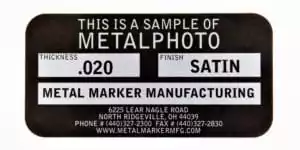While equipment nameplates and labels are often used in harsh industrial settings, it can be easy to overlook just how taxing other environments can be.
These vessels are constantly exposed to salt water, drastic temperature changes, impacts from waves, and more.
Boats and ships rely on durable boat safety labels to provide information to workers and passengers aboard.
Safety
Whether you are on a small private boat, or a massive shipping freighter; safety is paramount.
Everyone on the ship must be privy to the safety protocols and have proper warning messages and reminders. This saves countless lives, and helps passengers prepare for the worst case scenarios.
The American Boat and Yacht Council (ABYC) and US Coast Guard (USCG) each have their own recommendations and guides for what needs labeled on boats of all sizes. For example, they specify ship fuel tanks require proper identification.
If you’ve ever been on a boat of any kind, there is a high probability you have come across some form of nautical safety labeling. There are diagrams demonstrating the proper way to put on a life jacket or use preservation devices. Emergency supply locations are usually marked with bright colored labels. Larger ships are likely to have emergency exit indicators as well. This is just a few of many applications.
Other Applications
Ships and boats require an extensive amount of marking and labeling. Every control panel, piece of equipment, container, etc., need labeled. This applies to commercial shipping vessels, private boats, and military ships.
Another relevant type of identification is used primarily on shipping freighters. Shipping containers must be marked with many pieces of information to ensure quick passage through international ports. These are called CSC nameplates, and are a standardized solution in the shipping industry.
Durability
With constant exposure to weather and wear, durability is a key element for this type of identification.
However, specific applications will vary significantly. For example, a warning sign placed on the deck of a ship will receive constant abuse from saltwater, sunlight, and other weather. In contrast, a safety diagram labeling an interior piece of equipment will not face the same level of wear.
Selecting the right material and process for each application helps ensure your identification solution with meet your expectations. There is no one-size-fits-all solution.
Materials
Selecting the right material is paramount to the success of the identification solution.
For printed labels, there are many variations of poly/vinyl. Bear in mind these are not the most durable solutions. Laminates can be added to this type of label to provide a little bit of added strength.
For harsher conditions, there is thicker Lexan material. This substrate is more resilient, but is not a permanent solution by any means.
If durability is a great concern (which it often is for ships) there is the option of using a metal substrate instead. Metal tags and nameplates are excellent for boats due to their superior durability.
Marking Processes
Digital Printing
Alongside material selection, choosing the right process for your solution is equally important.
Digital printing is used to create custom designs on labels or decals. This topical ink can include multiple colors for custom logos and diagrams.

This process is excellent for safety and warning labels. Bright colors are often used to create vivid eye-catching graphics. This helps ensure the warning labels are noticed.
However, due to the topical nature of surface-level printing, this is not the most durable marking. The ink can fade or be scraped off, and will wear over time. This is especially true if exposed to harsh conditions.
While digital printing is great for interior surfaces on a shipping vessel, it is not recommended for exterior use.
Photo Anodization
For a more durable marking process, photo anodization is an excellent option. A custom design is embedded beneath protective aluminum layers to ensure maximum durability.

This process boats 20+ year durability in outdoor environments. The anodized aluminum material means these nameplates can withstand saltwater, corrosion, and other wear from life on the sea.
Full color designs are not available with photo anodizing, however a solid color can be applied to the background. This allows for color coding or labeling for warning purposes.
Wrap-Up
From logistics to leisure, boats are an integral part of transportation. In order to ensure the highest level of safety of those on board, ships and their crews utilize custom labels for safety and identification.
These nameplates and decals must be resilient due to their usage in harsh environments. With a range of processes and materials to select from, there is an ID solution for every boating application.